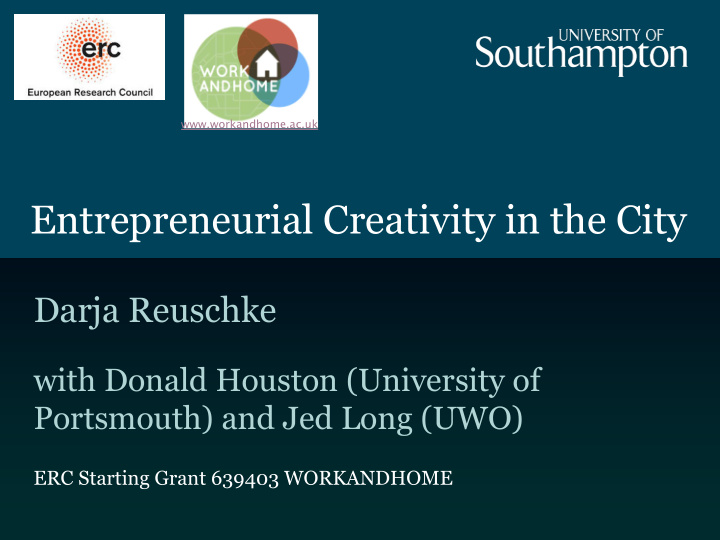



www.workandhome.ac.uk Entrepreneurial Creativity in the City Darja Reuschke with Donald Houston (University of Portsmouth) and Jed Long (UWO) ERC Starting Grant 639403 WORKANDHOME
Cities, creativity, innovation • Small establishments important for urban economic success (Glaeser et al., 2009; Rosenthal and Strange, 2009) • Location and attraction of economic creativity driven by diversity, openness, urban amenities and a sense of bohemia (Florida, 2002, 2003) • Florida (2003): Artistic and cultural creativity (openness), economic creativity (entrepreneurship) and technological creativity (innovation)
Entrepreneurs, bohemia and urban amenities • Locational preferences of creative or cultural entrepreneurs (He et al., 2018; Wenting, 2011; Heebels &Van Aalst, 2010) • Do entrepreneurs seek bohemian (open, diverse) places in which to live and/or to locate their business? • Quality of life or lifestyle (Bille, 2010; Clark et al., 2002) • Neighborhood- and city-level evidence is “muddled” (Shearmur, 2009)
Clusters and economic creativity • Clusters of creative firms • Creative activity as fixed in one place • Economic creativity has increasingly been performed by ‘independent’ workers (Mould et al., 2014) • Creative work is increasingly been done outside of fixed firm locations • Limitation of business register data and employment surveys
Workplace and residential locations of entrepreneurial business owners • Are entrepreneurial business owners more likely to live/work in ‘bohemian’ neighbourhoods than non- entrepreneurial business owners? • Do entrepreneurial business owners’ workplace and residential locations diverge from the general working population?
Locating the practice of economic creativity • How spatially clustered/centrally located are the practices of economic creativity in the city? • Twitter increasingly embedded in creative freelancers’ everyday work (Brems et al., 2017)
Intra-urban spatial patterns and neighbourhood types • Primary sample of small businesses located in the City of Edinburgh (2014, n= 153 business with 0-9 employees) • Working population with workplaces in the City of Edinburgh as a comparison group from Census 2011 • Identification of entrepreneurial small businesses: young and opportunity-driven start-up motivation • Identification of ‘cosmopolitan’ neighbourhoods using the ONS Area Classification (2011)
Residential location Neighbourhood type of All Sampled small residential location workers businesses Entre- Not entre- preneurial preneurial 29.5 50.0 28.8 Cosmopolitan Highly qualified 9.0 9.0 22.7 professionals 8.9 3.8 12.1 Ethnically and culturally diverse 18.4 - 4.6 Hard-pressed communities 10.9 6.4 6.1 Industrious communities Affluent suburban 8.8 20.5 18.2 communities Comfortable suburbia 7.0 3.9 * 7.4 6.4 6.1 Aging/rural Total 100 100 (99)
Workplace location Neighbourhood type of All Sampled small workplace location workers businesses Entre- Not entre- preneurial preneurial Cosmopolitan 51.5 75.0 55.4 Highly qualified 10.2 4.2 16.1 professionals Ethnically and culturally 19.0 5.6 7.2 diverse 8.5 * 5.4 Hard-pressed communities Industrious 1.2 * * communities/comfortable Affluent suburban 5.6 11.1 12.5 communities Comfortable suburbia 0.8 - - Ageing/rural 3.2 - * Total 100 (96) (97)
Entrepreneurial business owners • Attracted to bohemian neighbourhoods as places to work and live • BUT also attracted to mainstream and traditional affluent suburban neighbourhoods • Both cosmopolitan and bourgeois suburbs contribute to creativity (Phelps, 2012) • Life course factors are still linked to the residential locations of small business owners
Practices of economic creativity • Twitter network @WiredSussex of freelancers in the digital, media and technology sector in Brighton and Hove and the wider Sussex region • Identify creative freelancers and entrepreneurs using keyword search and network analysis • 451 freelancers and entrepreneurs with 1+ geolocated tweets from Brighton and Hove (14,514 geolocated tweets) – Designer, artist, founder, writer, photographer etc.
Classification of places • Point of Interest (POI) data produced by the UK’s national mapping agency, the Ordnance Survey (OS) • Third places (Oldenberg, 1989) – Cafés, restaurants, bars, hotel lobbies etc. – Libraries and community centres (Mertins, 2015) – Coworking spaces (Spinuzzi, 2012) • Cultural and leisure amenities (Clark et al., 2002) • Transport and public spaces • Natural amenities (He et al., 2018)
Classification of places (cont’d) • Education and health activities • Commercial places • Home/residential location – no commercial activity close-by & in overwhelmingly residential areas (ONS Workplace classification 2011)
Tweets per Output Area
Tweets by place type Place Category % tweets % freelancers Meeting spaces 44.4% 76.3% Coworking spaces 4.3% 28.8% Libraries/Community Centres 1.8% 16.4% Cultural amenities 10.4% 48.8% Leisure amenities 10.4% 48.3% Transport 3.4% 28.2% Public Space 1.1% 4.7% Natural amenities 1.6% 16.0% Education/Health 0.8% 7.5% Commercial 2.9% 19.5% Residential/home 37.4% 71.2% Unclassified 5.0% 35.0%
Combination of tweet places Sub-sample of Twitter users (n=229 Twitter users, n=13,907 tweets) • 8+ geolocated tweets • proportions of tweets per place type Cluster (k-means) 1 2 3 4 5 6 7 Meeting .35 .30 .60 .11 .06 .05 .10 Coworking .11 .03 .01 .02 .00 .00 .03 Library .03 .01 .01 .01 .00 .00 .00 Cultural .19 .07 .06 .03 .01 .02 .03 Leisure .14 .09 .08 .02 .02 .00 .03 Transport .04 .03 .02 .01 .01 .00 .02 PublicSpace .00 .00 .00 .00 .00 .00 .10 Natural .01 .01 .01 .01 .01 .90 .00 EduHealth .00 .01 .00 .00 .68 .02 .00 Commercial .02 .03 .02 .01 .00 .00 .07 Residential/home .08 .39 .15 .74 .20 .00 .14 Unclassified .03 .04 .03 .02 .02 .00 .48 n Freelancers 45 72 56 44 3 1 8
Conclusions • Complex locations of creativity in the city • Importance of residential homes/areas for economic creativity (Kiroff, 2017; Gornostaeva, 2008) • Not dualism of central-suburban or ‘diverse suburban economy’ (Phelps, 2012) • Diversity of types of residential neighborhoods, commercial areas and ‘third places’ -> urban eco-system • Creation and maintenance of attractive places to live and work and for ‘social interactions’ across the city to foster creativity and innovation
The intra-urban residential and workplace locations of small business owners. Journal of Urban Affairs (forthcoming) https://doi.org/10.1080/07352166.202 0.1768103 www.workandhome.ac.uk
Recommend
More recommend